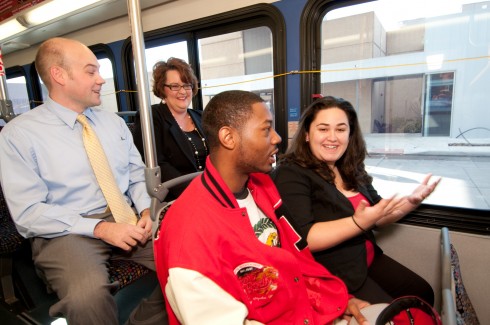KCATA Responds To Brookings Institution Report
Posted on: May 13, 2011
A Statement From Mark Huffer, General Manager of the Kansas City Area Transportation Authority
The Brookings Institution’s recently released report
“Missed Opportunity: Transit and Jobs in Metropolitan America” should be a clear call to regional leaders that transit needs to be an integral part of economic development and job access. In a ranking of the 100 largest metropolitan areas, Kansas City ranked 90th for transit coverage and job access.
While coverage and job access is good for those within The Metro service area, too much of the region is without transit access. This is particularly true in our suburbs. Too few citizens have a viable choice to ride transit, and too few jobs are located in those areas that have transit. Transit service is provided in a patchwork, with each local government determining how much transit service their citizens will have. Although The Metro operates in 10 different communities, only one (KCMO) has a dedicated revenue source to support public transit.
It is important to distinguish that the rating of the Brookings report is not about the quality of transit service available, it is about access to the service. Their conclusion: too few residents of our region have access to transit. We could not agree more.
The region needs to address these issues. One solution is a regional funding mechanism that would support transit for the Kansas City area, not just select cities. Transit service could then be provided in a more cohesive and comprehensive fashion. Realistic, sustainable land use policies should promote economic development patterns that allow local residents real transportation choices and access to jobs for which they have the skills.
KCATA has made access to jobs a priority in decisions about service provision and planning. We frequently hear from our customers how important our service is in getting them to work and in saving them money that is needed for housing, food, medical care and more.
Despite the challenges of providing transit in a low-density, road-heavy region, we continue to move forward and make improvements to transit in Kansas City. We have created two MAX bus rapid transit lines, which provide fast, frequent service and upgraded, high-tech amenities. With help from a federal TIGER grant, The Unified Government of Kansas City, Kan., and Wyandotte County is improving transit access along State Avenue, building transit centers and improving amenities at transit stops. Johnson County is implementing similar improvements along Metcalf, Johnson Drive and Shawnee Mission Parkway. In Missouri, KCATA, Kansas City, Mo., and Independence, Mo., are improving transit access in key corridors. The City of Kansas City, in partnership with KCATA, MARC, and Jackson County, is conducting an alternatives analysis that is generating excitement about the possibility of a streetcar line in downtown Kansas City.
The recommendation provided by the Brookings Institution rings true for our region: “These trends have three broad implications for leaders at the local, regional, state, and national levels. Transportation leaders should make access to jobs an explicit priority in their spending and service decisions, especially given the budget pressures they face. Metro leaders should coordinate strategies regarding land use, economic development, and housing with transit decisions in order to ensure that transit reaches more people and more jobs efficiently. And federal officials should collect and disseminate standardized transit data to enable public, private, and non-profit actors to make more informed decisions and ultimately maximize the benefits of transit for labor markets.”
The
Brookings Institution report is available online and includes
interactive mapping tools.


